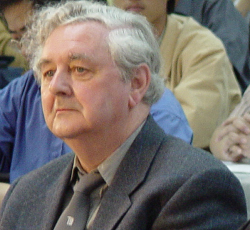
Engineering geologist par excellence, whose wit was legendary
Alastair Lumsden sadly died aged 81 on 22nd July 2019, after a short illness. He was a great man, an engineering geologist par excellence
Alastair attended the Royal Grammar School, Newcastle, from 1949-1956, where he was renowned for his sporting prowess, particularly on the rugby field.
He graduated in Geology from Durham University in 1961 and subsequently went off to Australia to the Geological Survey of Queensland (1963-1966), conducting regional and local hydrogeological surveys and engineering geological investigations throughout the State.
From 1968 to 1970 he worked as a Senior Hydrogeologist and Resident Engineer for groundwater investigation for the Lar Dam project in Iran. Following his return to the UK Alastair became a lecturer/senior lecturer in engineering geology at Trent Polytechnic (1970-1974); he also completed an MSc in hydrogeology by research at Newcastle University during this period.
Revitalising the Leeds MSc in Engineering Geology
Subsequently, in 1975, Alastair moved to Leeds following the sad death of Alan Gaskin. Here he re-vitalised the MSc in Engineering Geology. By the time I got there in 1984, the course was thriving, gaining plaudits and NERC scholarships – I recall that we had six which was a mighty achievement compared to our colleagues at Imperial, Durham and Newcastle. He had already graduated Doug Stead and Martin Culshaw and had a PhD student, Stavros Bandis, whose research was awarded the Manuel Rocha prize of the ISRM. This research resulted in the publication of a classic scientific work “Fundamentals of Rock Joint Deformation” by Bandis, Lumsden and Barton – which has received over 1700 research citations.
Research continued with Altay Acar (Turkey), Abbas Al Harthi (Saudi Arabia), Qui Hong Liao (China), Theo Papaliangas (Greece) and numerous UK students - to name a few, Simon Welsh, Keith Rawnsley, Dawn Nicholson, Chris Power and Jared West, who is now Deputy Head of School at Leeds.
The Geological Society and the Institution of Geologists
Alastair played an active role in the Geological Society (GS) and the Institution of Geologists (IG) – he was on the Councils of both, chaired the Regional Groups committee for three years, and from 1989 to 1991 was the co-chairman of the IG/GS Reunification Committee. He was a Chartered Engineer, Chartered Geologist and Fellow of the Society.
His wit was cool, calculated and legendary. I remember telling him happily that my wife was pregnant again (our two younger ones were 16 and 11). He commented drily “I would have thought that someone like you, with a penchant for research, would have by now figured out what was causing it!”
He was a stickler for grammar; no split infinitives here. When he retired, he took on the role of Editorial Manager of the Journal of Petrology to assist his wife Marjorie. He worked full time in this role until the age of 80 – putting his talents to good use.
Alastair’s legacy will always be the MSc in Engineering Geology at Leeds. He built the course from scratch, teaching it using the three verbal equations of engineering geology that he developed with Professors David Price (Delft) and Sir John Knill. Sir John, by the way, was a regular visitor at Leeds, enjoying fish and chips at Alastair’s favourite restaurant, Bryan’s, in Headingly. When I was there the numbers were typically 10 to 20 students per year; now they are up to 36, taught by Bill Murphy, Jared West, Mark Thomas, Mark Hildyard (another Manuel Rocha prize winner), Antonio Abellan Fernandez and Chrysothemis Paraskevopoulou. Long may the MSc course continue to flourish.
Alastair was married three times. His first marriage to Margaret ended in divorce, and his second wife Jean sadly died of breast cancer in 1986. He is survived by his wife of 23 years, Marjorie Wilson, Emeritus Professor of Igneous Petrogenesis at Leeds, and by the three children of his first marriage, Michael, Karen and Iain.
By Steve Hencher